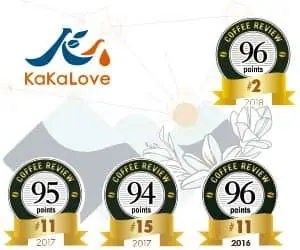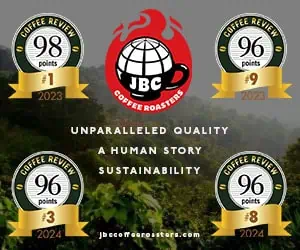Although this quietly elegant Brazil didn't attract the sort of raves the highest-rated Guatemala elicited in our July 1997 cupping, it did stimulate admiring comment and the highest rating in the cupping. "Excellent overall. Stands by itself as an estate coffee." "This coffee is the best of the lot." Admiration centered on a smoothly substantial body and a deeply nuanced flavor. Three reviewers identified the grace notes as chocolate, a term that came up only occasionally with other coffees. One even qualified chocolate by category: "bittersweet chocolate, not sweet!" .
Although this dry-processed coffee scored roughly the same as the three preceding samples, reviewers' comments seemed to indicate a coffee with more character and development. No faults or weaknesses were noted, and a tone of quiet respect ran through the few comments on flavor and aftertaste: "smooth - mellow"; "very pleasing." A split vote on body: about half the reviewers who commented found it heavy, and about half thin or light.
An almost textbook example of a carefully wet-processed, soft-bean, low-altitude coffee: light-to-medium-bodied, free of defect, pleasingly soft, slightly sweet. Reviewer consensus on all of the above, although one (who admitted his dislike of washed Brazils in his cover note) concurred with the overall description but still didn't like the coffee.
We couldn't make up our collective mind about this wet-processed coffee. I found it light and pleasantly bright -- appropriate to a good wet-processed coffee from lower altitudes. Several agreed, finding the acidity fruity and sweet. Others, however, reacted critically to the delicate profile: "Washed ... blah!" exclaimed one. Assessments of body were surprisingly varied, ranging from thin to buttery and full. Finally, two reviewers found flat-out fault with the profile: "dirty," complained one; "baggy" (flat, ropey taste), accused the other.
"Yes! This is a coffee for non-believers. This sample will convert the pagans," wrote one reviewer, apparently a supporter of Brazil coffees. Well, most of the pagans stayed unconverted, still groveling about before their acidy Central-American idols. The usual vanilla and nut tones were noted approvingly in the aroma, the soft sweetness of the acidity observed, but little enthusiasm emerged in the categories of body, flavor or aftertaste. "Not much depth," complained one. "Very uniform throughout the range in all taste aspects," remarked another carefully, "not lacking anything in particular, yet not exceeding in any category either." Three reviewers noted mild faults, two with a forest products theme: "papery; wet cardboard," said one; "woody" complained the other.
Virtually everyone had something positive to say about the aroma of this delicate, semi-dry-processed coffee: caramelly, vanilla-like, nutty. However, the comments dwindled thereafter, which supports my assessment: lively, complex nose, but no development. Solid consensus on body (medium) and acidity (soft as usual). Only two hints of fault: one cupper, who otherwise liked the coffee, found the aftertaste slightly medicinal. I thought I detected a slight grassiness in both aroma and aftertaste.
"Clean, monolithic," one cupper wrote. "OK but same old same," wrote another. One of four coffees in the cupping for which no faults whatsoever were cited; on the other hand, this carefully prepared coffee elicited only mild praise. The acidity was predictably characterized as "soft" (five of ten reviewers). Words like sweet and caramelly popped up occasionally. Only one reviewer actually effused: "chocolaty and sweet; nutty flavor."
It wasn't entirely clear whether it was a thin, attenuated quality that put this semi-dry-processed coffee near the bottom of the cupping (three reviewers explicitly used the word "thin"), or an off-taste too subtle to be called a defect but unpleasant nonetheless. I called it a "baggy hardness"; three other panelists also used the word "hard" to describe it; others used close synonyms like harsh and bitter. On the positive side, several praised this coffee's sweetness.
Perhaps this coffee was betrayed by our sample roasting. Four of ten reviewers mentioned burned or smoky tastes that may have been owing to a rushed or overdeveloped roast. Two identified a fault that may be associated with the coffee and not the roast -- a slightly medicinal or harsh character. No grace notes were cited, although the term "soft" came up frequently as usual. I was definitely in the minority with this coffee: I felt it required patience, but developed nicely: "At first heavy but nondescript, but then a gentle, light, levitating sweetness dances off the top," I wrote.
The two reviewers who liked this coffee knew they were going to take it from the purists when they gave it their highest and second-highest scores respectively. "I found [it] ... the most interesting and complex [of the coffees in the cupping] with a distinct fruity (but not fermented) tone, but I'm not sure it would be considered a good coffee by most," wrote one admirer. "Perhaps a bit controversial - some Yemen-like fruit," wrote the other.Controversial isn't the half of it. Eight of ten cuppers read this coffee as defective, and five specifically as fermented, a flavor defect caused by the sugars in the coffee fruit going off during drying. Four gave it the lowest possible score of 50, and one exclaimed "50? more like 10!"So is this coffee complex and fruity (two votes), fermented beyond acceptability (four votes), or flawed but acceptable (four votes, including mine)? If there were a certain answer for this question cupping wouldn't be half as much fun, but if we go by numbers alone the bad-coffee camp has it. For more on the "is this coffee fruity or is it fermented" issue see my comment and George Howell's response in the August 1997 issue of Coffee Review.










